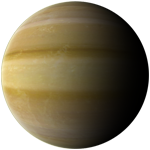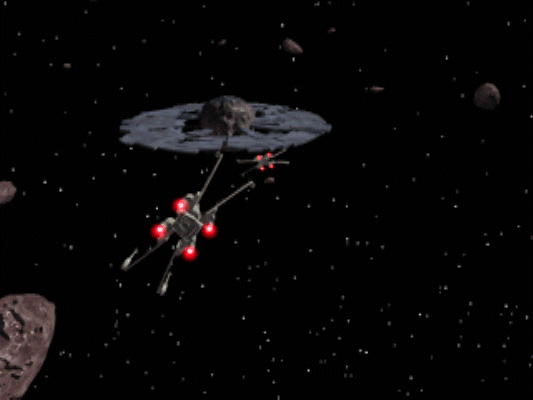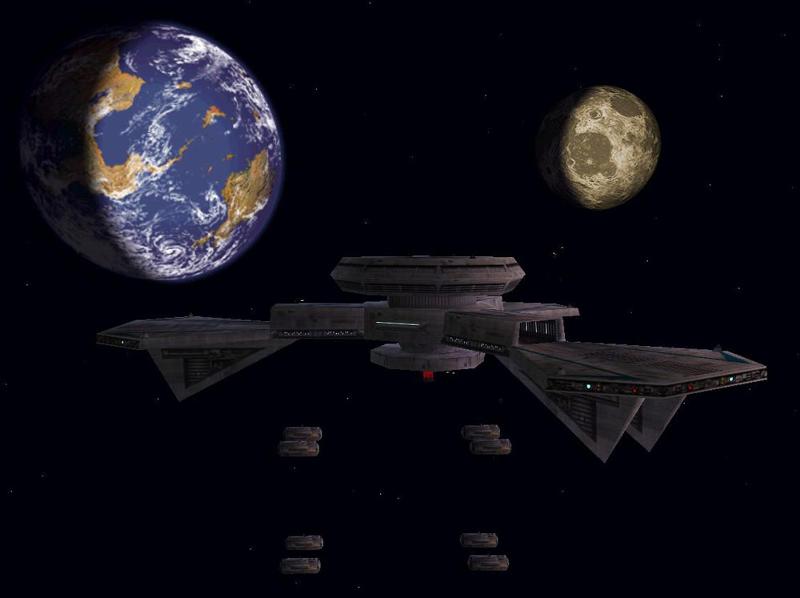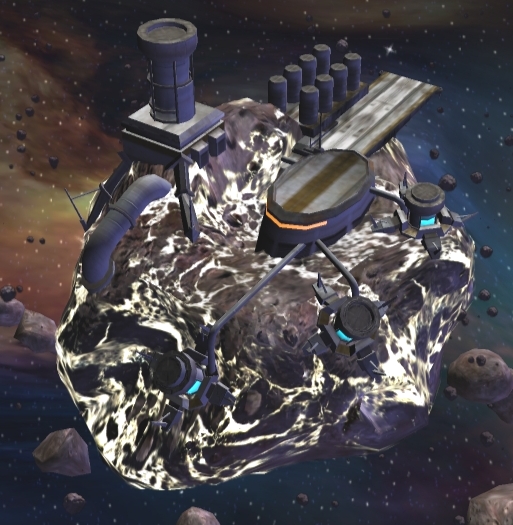For each of the 19 systems we code, there is a pre-work page on Starwars canon information. The whole community can discuss on canon they got from books or sometimes just to generate new ideas to add to the system.
Here is an example on the Hoth system.
For the dynamic economic (a plugin on FLHook) we intend to build, the Hoth system is 'outer rim' which means a place to gather (mine) raw materials that can be processed on the core worlds. Some products will be needed to re-construct cap ships that are lost on Territorial Engagements (every weekend). So it will be extensively provided with minable asteroid fields.
System Hoth
Hoth on SW Combine
The remote Hoth system is located in the Curba sector on the fringes of civilized space. It has many planets, including: Belethon, Milegrog, Durnost, Calilas, Corin, Hoth, Tarador and Angarhutillian. These planets are generally hospitable, usually containing some element of cold, but most of them have plenty of water and lush forests. Located near the Hoth planet is a large and dangerous asteroid belt, which was formed billions of years ago by the collision of two planets. This was a result of an unfortunate consequence of the Hoth system causing some planets to fall out of orbit. Currently Calilas is on root to falling out of orbit as well. It is rumored that within these asteroid belts are the planets pure platinum cores, completely intact from the collision. A scientist one discovered one of them but lost it when running back to civilized space to verify its purity.
One some asteroids grow delicate crystal ferns which might possibly be a very primitive silicon-based life form. Other asteroids were once used by pirates who used gigantic space slugs to protect their outposts. Unfortunately these space slugs grew, eating off the silicon-based life form and eventually consumed the outposts. Travelers should be wary when entering the asteroid field.
-->wookipedia
The Hoth system was a remote star system located on the fringe of the Ivax Nebula in the Anoat Sector of the Greater Javin in the Granita Cluster, along the Ison Trade Corridor at the edge of the Outer Rim Territories.[source?] The Hoth system was the one-time location of the Alliance to Restore the Republic's Echo Base; and in 3 ABY, the Battle of Hoth, a crushing defeat of the Rebellion by the Galactic Empire, led by Darth Vader.[1]
The system comprised six planets, including a wide and chaotic asteroid belt at the farthest orbit. Debris from this belt caused substantial meteorite activity on the planet Hoth.[1]
The Hoth system was possibly named after Hoth, the famous Jedi Master.
Belethom-------------cold/breathable-------------civ
Belethon, found in the Churba sector in the Hoth system is an interesting planet. It does not have much history to it, aside from the occasional science team, but the wildlife is especially interesting.
In the north of the planet are large glaciers. These glaciers found at the polar caps have been there for such a long time that creatures and plants have developed resistance to the cold weather in such a way that they are able to survive even the coldest temperatures on these polar caps. Several species of trees and plants have adapted in order to suck nutrients out of the snow as opposed to the soil. Other plants have roots which are strong and are able to dig through the snow and able to break the permafrost. This creates large forests in some areas in the north, despite the cold temperatures. The planet does not rotate on an axis, allowing the north and south poles to get sufficient sunlight all year round.
In the middle of the planet is the Machiavelli Volcano range. These Volcanoes, named after a famous old Republic politician, stretch across much of the planets surface. These volcanoes are interesting on there own. They seem to extend from the north, down towards the equator where the volcano range goes underwater. Despite being a relatively cold planet, the volcano causes the ocean to warm up to extreme temperatures, some even boiling, even in the worst of winters.
As well, these volcanoes have their own wildlife. For example the Tokienian plant thrives off of heat, using the magma as a source of nutrients. Ironically enough the plant is so resistant to heat that often it is used in the manufacturing of durasteel. The planet sucks the nutrients out of the magma as well as the liquefied rock, creating a tough coat of armor around it.
The grass plains are home to the flatland wampa, a similar species to the wampa found on Hoth, however far less dangerous. In fact this wampa, having a brown fur coat, dull claws and harmless teeth, eats plants as opposed to people. This has much to do with the more hospitable climate found on Belethon.
In the south there are incredibly large lakes. These two lakes used to be part of southern ocean however the ocean began to freeze. These two lakes did not become part of the freezing because of the volcanic climate in the north west or east. These few volcanoes managed to erupt frequently depositing hot ash in these lakes. As a result, they were not able to freeze like the rest of the ocean. As a result there are several consequences. Both these lakes are salt water. However the salt is nothing compared to the large amounts of ash covering the lake. In some places the salt and ash are so thick that you can walk on top of the water.
Another consequence is the sub-aquatic marine life. Little is known about the creatures that dwell but it is believed that these lakes go incredibly deep and under the glaciers. Although it is extremely dark, several huge gigantic whales of some sort dwell beneath the ice. One was captured on film during a scientific expedition and it was estimated to be approximately one kilometer long.
Milerog-------------temperate/breathable-------------civ
Milerog is a planet found in the Churba sector in the Hoth system. This planet is average size and is temperate and breathable. This planet has large amounts of water, consisting of one major continent and one major ocean, the Aneima ocean. This ocean covers about half the planets surface and has two large islands, one which is almost entirely volcanic and another which consists of nice grassy plains as well as thick tangled jungle.
In the north is a small ice cap. The south is significantly warmer due to the planets 30 degree axis. However as the planet rotates, the south becomes colder and the north warmer. The interesting thing is that this planet has a day cycle of about three thousand years. Currently the dark side of the planet is the one which is covered by ocean. Due to the unique way that the sun shines its light on this planet, only a small portion of the planet is consumed in darkness at one time, but this time period lasts over a thousand years.
In the oceans are many types of fish. These fish have evolved to be able to survive both with much light and with completely no light in order to compensate for the irregular night/day schedule. In the depths of the ocean it is believe to be a large capital ship, crashed down from space many years ago. Rumor has it that it was part of the Katana fleet, however no one has been able to dive down that deep into the ocean, even with modern technology. Fish guard the ocean like it is a high secret military installation. The fish are incredibly predatory of any creature it does not recognize. They are also incredibly large, some dwarfing the x-wing, and have great big teeth, on average. It was rumored that these fish are extremely predatorily due to some science experiment gone wrong.
The jungles in the forest are incredibly barren of life. They almost exclusively have one type of tree, the D’anaj tree, measuring 10-20 meters high. These trees grow so close together that it is almost impossible to navigate through a jungle. The entire jungle seems to be one entity as a whole. It is not believed to hold any wildlife.
The desert is a large one which used to contain surprisingly enough, imported sarlaacs, which seemed to have been introduced there over a thousand years ago in order to combat a growing infestation of Y’aldak rats. The Sarlaacs were so effective that they made the entire population of Y’aldak rats extinct as well as killing off most of the other life in the desert. As a result, the Sarlaacs soon died off, void of food. The pits remain to this day and serve as a very nice shelter from the cold desert nights.
The island in the south west of the planet is pretty simplistic. It has a similar jungle as the one on the main land and is near several grassy plains. On the plains there are not much aside from your boring animals. These creatures are typical to those found on most habitable planet, just normal boring herbivores and a few simplistic carnivores.
Durnost-------------gas giant------gas mining station in orbit-------civ
Niekerkshoop Gas Mining
Durnost is a gas giant in the Host system in the Churba sector of the galaxy. It is a normal gas giant, similar to the ones found all over the galaxy. It is filled with large amounts of Tabanna gas which allow mining companies to come and mine it.
Deep within the planet there is large amounts of air packed together so thickly that one can walk on it. Through an interesting chain reaction, large amounts of nitrogen were isolated from the other gasses in the planet and formed their own patch. Eventually the nitrogen became so backed together that it was able to support weight. Currently they can support about two tons without collapsing. These patches are found all around the planet and can be invisible. Fortunately they aren’t thick enough to cause a ship any damage if one were to run into one, which is a very good thing as these patches are invisible.
This planet has very little history to it. In fact only a few people have ever ventured into the atmosphere. A few freighters looking for a nice place to mind stumbled upon this planet about twenty years before the Empire and discovered the patches of near-solid gas.
Calilas-------------temperate/breathable-------------civ
Calilas is found in the Hoth system in the Churba sector. It is a temperate planet, home to lots of wildlife, found generally in the jungle and the forests. This planet also has a large river running right though the main continent. It has two cities, both owned by Cloud City, and the planet as a whole has a population of just under 500 000 people. This planet also has large amounts of glaciers as well as massive volcano ranges.
In the south and north are two large ice caps. These Ice caps have been growing lately, as a result of global cooling. Slowly the planet is drifting farther and farther away from the sun. It is expected that in about two thousand years the planet will completely leave orbit, however this could be a result of bad calculations. As the planet moves farther away from the sun, the temperature slowly cools causing the ice caps to grow over a period of the last thousand years.
The river in this planet is home to much wildlife. The Besii river is freshwater and is filled with many types of aquatic fish. These fish are so beautiful that often they are taken away and used as pets on worlds such as Coruscant and Kuat. These fish are generally vibrant in colors, the river being filled with some of the easiest to keep freshwater fish in the galaxy. As well, the river offers few aquatic predators allowing the fish to live quite well except during breeding season. During breeding season many of these fish return to where they hatched where often they find a large host of predators waiting for them.
Some of the predators include the Calilaian wolf, a large four legged creature that has brown and black fur, a long snout and pointy ears. It is able to swim quite well and can usually eat quite a few fish in a very short period of time. As well there is the Calilaian bear, which is a large beast which often manages to eat these beautiful fish as well.
In the jungle in the south the wildlife is quite extraordinary. In fact it is believed that only about 1% of the species have been discovered. Some of them include the Calilaian nerf, the Calilaian parrot and of course the Calilaian mustang.
The forests are not quite as diverse as the jungles, however they are diverse. They have many types of trees, some as tall as a small star destroyer stood upright, while others are much smaller, only about 10 meters long. The wildlife includes many dangerous predators, such as the bears and wolves mentioned above.
The cities are nothing special. Many were founded recently when it was discovered that there might be mineral deposits deep within the surface. They are situated in the east and west of the planet and consist of 100% of the planets economy. Both of the cities are located right next to an ocean, providing a perfect place for a harbor.
Asteroid Field 8945-------------asteroid field----station------confederation (Krath)
Viljoenskroon Proces Plant
The Hoth asteroid field was an extensive, wildly erratic asteroid belt occupying the farthest orbit of the Hoth system in the Outer Rim Territories. Forged as the resulting effect of a collision between two rocky planets eons prior to the Galactic Civil War, the belt was a favored sanctuary for smugglers and pirates alike hoping to elude legal authority. The field was rich in untapped mineral resources such as metal ore, a magnet for mining prospectors hoping to make a fortune. The chaotic nature of the asteroid field sent a constant bombardment of meteorites to the surface of Hoth, the system's sixth planet.
Following the Battle of Hoth in 3 ABY, Han Solo braved the perils of the asteroid belt in the Millennium Falcon as part of a desperate ploy to escape the Imperial Navy, successfully navigating its expanse against all odds. Later, in 12 ABY, the Hutts used the belt as the construction site of the Darksaber Project, a planet-destroying superweapon designed to dominate the galaxy. A New Republic attack force under the command of General Wedge Antilles pursued the weapon through the field, and it was ultimately destroyed after being crushed between two planetoids.
Asteroid Field 8321-------------asteroid field----station---------civ
Lourisfontein Cargo facility
Hoth sun-------------powerful yellow sun
Corin-------------gas giant-----mining station (abandoned?)--------civ
Hoopstad Gas Mining
Corin is a gas giant which by its nature is quite large. It is found in the Hoth system in the Churba sectors located in the bottom sector of the galaxy. The planet has a little history to it. It was discovered with the rest of the system many years ago and has seen little activity since. Cloud City has tried to mine the gas however the operation was a money pit and was quickly abandoned.
This planet is interesting because the gas itself is enriched with nutrients left over from asteroids that have collided with this planet. As a result, trees and plant life have been able to form on this planet despite its lack of a surface. In many places, trees that are half solid half gas would form, rooting in the clouds. The planet has large quantities of water floating in the air with the rest of the planet creating a prefect environment for trees to grow. This did not work out well for cloud city as it made finding a suitable mining place difficult. To add to complications, the water and gasses would clog the pipes and mines of any mining operation. Cloud city soon abandoned this project.
Hoth-------------cold/breathable-------------civ
The planet Hoth, located in the system of its same name and found in the Churba sector is infamous for its cold temperatures. On average during the day it can drop to negative 30 degrees (Celsius) but during the night it can drop as much as thirty degrees lower. With temperatures so fierce it is amazing that any life could survive here, however it does.
All around the planet are many Tauntauns. These creatures eat the fungus that can be found in the many caves that grow beneath the layers of snow. These Tauntauns also group together and sleep in caves to protect them from the cold. However these caves bring forth other dangers. Often living in these caves are the ever hungry wampas. They capture their victim, usually a Tauntaun and hang it up to dry. They then save their food as it is usually a long time before they are able to eat again.
Located in the south is a thousand kilometer long chasm that was formed by frozen ice geysers and the pressure of surrounding cliffs which have so much pressure it keeps the water warm enough not to freeze. Here there are many amounts of fish life that are able to survive in the cold water. These include the Emillii fish, a long and skinny fish with a large sword for its tail and a beak for its nose. The fish breathes though its beak, as inside are gills which filter the water to provide it with oxygen.
In the west there is a small outpost which was used by smugglers in the past. Unfortunately it was abandoned as a result of attacking wampas. These wampas were able to kill almost all the inhabitants ands now the facility lies barren. These wampas are incredibly dangerous and are superb killers.
Tarodor-------------gas giant-------------none
Tarodor is a large gas giant located in the Hoth system in the Churba sector. It is a fairly typical gas giant, made up principally of nitrogen, oxygen, methane, carbon dioxide, hydrogen, helium and tabanna gas. This gas giant has little history to it, being found in the remote and under populated Hoth system. Several companies have scouted this area out looking for suitable place to mine, however most places were rejected because it is such a remote system. It is located in the far reaches of the galaxy and there are plenty of gas giants closer to the core that are much more suitable places to mine. Even within the Hoth system it is quite a ways away from the other planets. The sun is quite far, causing the planet to be very cold. In fact it is so cold that often it rains liquid oxygen, a result of the gas liquefying. As a result of this, often the entire planet is a mix of storms, freezing cold oxygen pouring down within the gas giant, being spun around at rapid speeds by an incredibly large hurricane that consumes most of the planet. It is very hospitable except in a few areas.
Angarhutillian-------------cold/breathable-------------civ
Angarhutillian is a cold breathable planet located in the Hoth system in the Churba sector. It is very cold as a result of being very far away from the sun, however it is quite habitable despite its cool temperatures. Although the planet receives little heat from sunlight, the volcanic ranges found in the middle circle of the planet are able to provide heat for the central areas, a result of wind carrying all heat to the center of the planet. In the north and south are ice caps where the average temperature is below negative one hundred degrees. However the volcanic ranges have created an average temperature for the rest of the planet at about positive 10 degrees.
In the south there is a large forest with consists of many large coniferous trees which are usually quite tall, some going as high as fifty meters. Here there are large types of wildlife such as the Knnonna, a Kangeroo-type creature that is able to jump up to ten meters in the air, perfect for climbing trees. This creature eats the thickly coated pine cones that the trees produce. As well there is the J’dja bird, a large eagle-like bird which has a five meter wingspan. This bird is so large that it is able to swallow a small human child whole. However it mostly stays in the upper levels of the forest in order to eat the animals that reside in the trees canopy.
In the far north are two craters, a result of fallen asteroids. These asteroids hit the planet and were able to penetrate the ice so deep that they hit the ground and created a crater. Although the crater is only 200 meters deep below the ground, the ice glaciers rise up several kilometers above the ground, creating a very deep crater. As well, the pressure from the surrounding ice caps cause the craters to have a nice temperature of about 10 degrees during the day, and 0 during the night.
In the middle of the planet is a large ocean, a result of melting ice caps drifting towards the center of the planet as a result of the strange wind patterns caused by the volcanoes. This ocean is fairly warm with swimable temperatures. In fact it was set up as a tourist resort several thousand years ago when this system was habited. Unfortunately the Old Republic thought this planet was evil and boycotted the tourist industry, who soon gave up on any source of revenue.
Inside the ocean are a variety of fish, mostly small friendly types however there are some large predators. Located in the south of the ocean is something that can only be described as an Aquatic Dragon. It is long, stretching about fifty meters, and it has an incredibly long tail. Its scales ride up its spine and it is a reptile, complete with four legs and scaled skin. It can survive for several days without water.
The ocean isn’t incredibly deep, only about a kilometer at the deepest parts, with one exception. Located in the middle of the ocean is a crevice which is believed to travel down deep into the earth’s core. This causes the area to be incredibly hot. Another factor as to why the ocean is incredibly warm is that there is a river running from one volcano range straight into the middle of the ocean. This current causes the ocean to heat up to 35 degrees in some areas. Better yet, the ocean is a fresh water ocean, allowing very nice swimming conditions.
Asteroid Field 8763-------------asteroid field-------station------civ
Klipplaat Mining station








